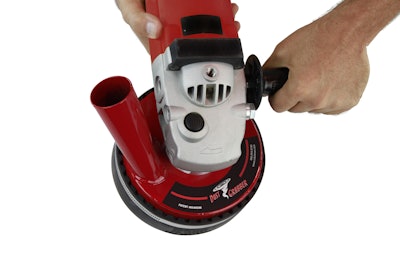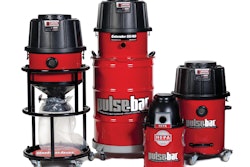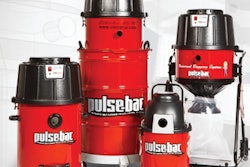
What is Table 1? First it's important to understand that the rule lays out two options for controlling dust. Option 1 is, in short, control silica with your own methods and then measure your employee's silica exposure through medical testing and other methods, which can be complicated and expensive. If exposure is at or above OSHA's requirement, you have to find better methods. Option 2 is to follow the dust control methods in Table 1 of the new rule. With Option 1, you're basically saying, "I've got my own way to control silica dust" and you're going to take the time and expense to test your idea. If your idea works you are set, but if not, you do it again until you're in compliance. For many businesses this isn't going to be very practical making Option 2 (Table 1) the better choice. Plus, according to OSHA's fact sheet, those who follow Table 1 correctly are not required to measure workers’ exposure to silica and are not subject to the PEL.
Table 1 shows dust control methods for many common operations. For stationary masonry saws, hand saws, walk-behind and drivable saws as well as rig-mounted core saws/drills, these tools must be equipped with an integrated water delivery system that continuously feeds water to the blade or bit. Many models of saws and drills include this feature from the factory and aftermarket kits can be purchased for older models. This makes compliance on these operations pretty straight forward. However, other operations have different requirements.
Things like cutting fiber cement board, tuck-pointing, dowel drilling and using handheld and stand-mounted drills require a dust shroud and a connection to a dust collector. Jackhammers and chipping tools like hammer drills as well as handheld grinders and walk-behind floor grinders can use water or a dust collector.
An interesting point are the requirements Table 1 places on handheld grinders for tuck-pointing and for "other purposes". It states the vacuum should have 25 cfm per inch of blade diameter. So for example, Pulse-Bac recommends a 550 model vacuum that produces 124 cfm for tuck-pointing with a four to five inch grinding wheel, meeting the Table 1 standard. That same 550 model previously worked great for a grinder with a seven inch cup wheel. However, according to the new rule, the seven-inch grinder would now require 51 more CFM for a total of 175 CFM, even though before the 550 had been a very effective solution. Now the user must move up to something like a Pulse-Bac 1150 model, which is not only more powerful, but larger overall.
Along with the requirement for using a dust collector, Table 1 also places requirements on the dust collector itself. The following appears almost everywhere a dust collector is called for.
"(the)Dust collector must provide the air flow recommended by the tool manufacturer, or greater, and have a filter with 99% or greater efficiency and a filter-cleaning mechanism".
To better define what this means we'll look to the text preceding Table 1. First let’s address filter efficiency. The text shows that OSHA had originally considered requiring HEPA filters like those used with lead paint & asbestos, which provide 99.97 percent filter efficiency at .3 microns, since they provide better respiratory protection. However, OSHA found that many HEPA filters clog quickly and that there were more filter options close to HEPA available, allowing the standard to be more easily implemented. This is why OSHA went with a lower filter efficiency of 99 percent. However, vacuums like Pulse-Bac feature HEPA filters to provide the best protection and with the automatic pulse cleaning, filter clogging is a non-issue regardless of filter efficiency. So, when you're looking at filtration from a compliance standpoint, while a HEPA filter will provide better protection, you're only obligation is a filter that provides at least 99 percent filtration(X). The table is ambiguous as to the particle size(Y) to be filtered (filter efficiency = X% at Y micron), but to be safe it may be good to find something in the 0.3-0.9 micron range, as this would fit what is discussed in the preceding text.
Now let's look at the second part of the requirement, that the dust collector be equipped with a filter-cleaning mechanism. A “filter-cleaning mechanism” could mean a lot of different things, so we need to interpret what the expectation may be. Here again we turn to preceding text. There we find OSHA saw fine silica dust would quickly clog standard vacuums. They looked at data from NIOSH,
“NIOSH pointed out a reverse pulse feature on a dust collector should preclude the need to remove filters for cleaning. OSHA agrees and has included the specification for a filter cleaning mechanism”.
Other statements provide further insight: “the filter(s) on the vacuum must be cleaned or changed as frequently as necessary in order to ensure they remain effective (it may be necessary to activate a back-pulse filter cleaning mechanism several times during the course of a shift).” and "regular stops to conduct the proper reverse air pulse filter cleaning procedure were crucial ..."
This makes it clear that filter cleaning is an important part of the requirement of Table 1 and the filters will need to be cleaned frequently to be in compliance. While this may slow work down, a vacuum with an automatic pulse cleaning feature will eliminate the need for monitoring and work stoppage for manual cleaning.
Table 1 seems to show, although now regulated, a lot of these requirements can be met with fairly common practices. For example, many people already use a vacuum with a concrete grinder. Now they just need to make sure it has the right filter efficiency, a filter cleaning mechanism and the correct CFM. They might want a vacuum that does the work of filter cleaning automatically to avoid frequently stopping work to push a button, shake or change a filter; or the convenience of a water recycling system for operations with water system requirements. However, these are things that provide benefit and convenience regardless of the rule. So although the change may seem big on the surface, the reality is many items that previously just made work healthier may now make compliance easy as well.
Ed. Note: For more information on Table 1: Specified Exposure Control Methods When Working with Materials Containing Crystalline Silica click here.
Ben Kruse is the marketing director for Pulse-Bac. He can be reached at [email protected]



















